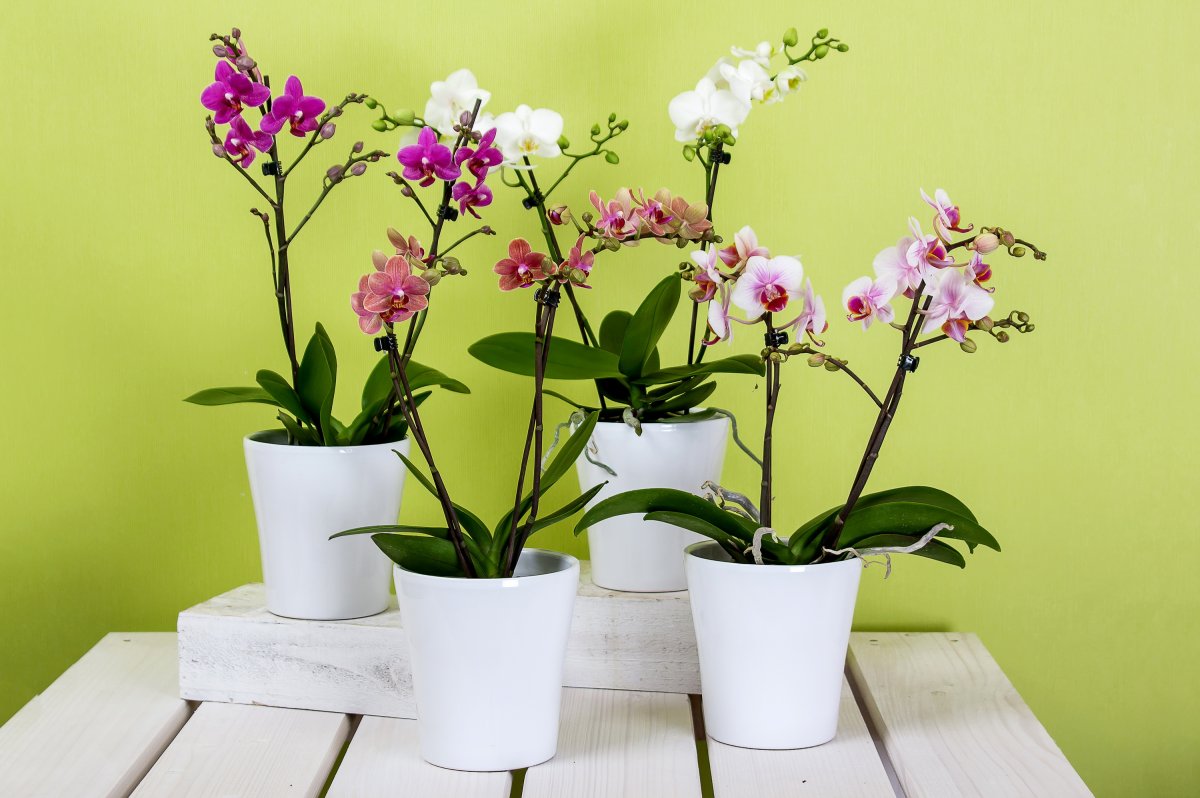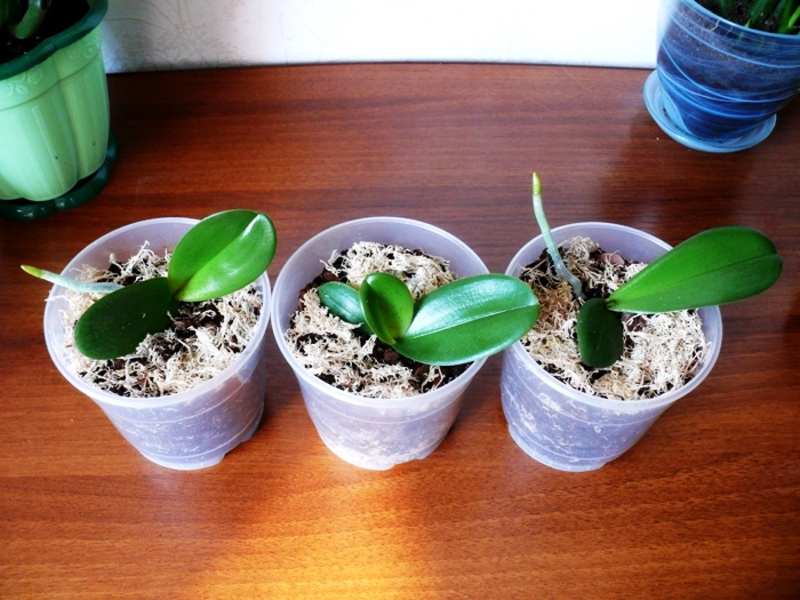Phalaenopsis Orchid is much easier to grow at home than other representatives of epiphytes. In their natural habitat, these plants prefer the tropical climate of New Guinea, Brazil or Australia. You can find these beautiful flowers at an altitude of more than 500 m above sea level.
Content
Description of Phalaenopsis orchid
 The stem of this plant does not branch, like other orchids, but grows in length, reaching about 50 cm. During the year Phalaenopsis forms no more than two leaves.
The stem of this plant does not branch, like other orchids, but grows in length, reaching about 50 cm. During the year Phalaenopsis forms no more than two leaves.
Orchids bloom from the stem to the top and delight with beauty for 2-3 months. The inflorescence is up to 60 cm long and is a branched raceme with many large flowers, which reach 12 cm in diameter.
The plant's root system is quite original. The roots come out in different directions and have a greenish tint. With the help of the roots, the orchid provides itself with minerals and moisture from the air.
Professional florists distinguish three basic rules that must be followed when caring for orchids:
- excess moisture is fatal to the roots;
- roots require air and lighting;
- an ordinary flower pot and soil is used by the orchid only as a support.
How to water phalaenopsis
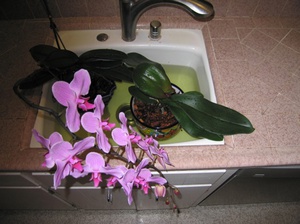 According to experts, the health and beautiful appearance of the orchid will depend on the rules of the watering regime.
According to experts, the health and beautiful appearance of the orchid will depend on the rules of the watering regime.
Phalaenopsis can withstand drought with ease and without any consequences, but strong watering is contraindicated for him.
The soil should dry thoroughly between waterings. How to know if an orchid can be watered:
- Gently get out a couple of pieces of soil and feel the moisture by touch.
- When the pot is transparent, you can simply look at the condition of the soil.
- By the weight of the pot, since dry soil is much lighter than wet.
After a certain time, you will be able to draw up your own schedule for watering the plant. As a rule, in winter, the orchid is watered every 14 days, in summer - once every 3 days.
Watering Phalaenopsis need so that the soil is well wet... For this, the pot is immersed in water for 15 minutes and additionally sprayed. Then allow the water to drain and set the pot in place.
Water is required warm, since Phalaenopsis is a plant from the tropics and does not like cold snaps. The watering procedure, as a rule, is performed at the beginning of the day, so the plant will be already dry by evening. For watering, you need to prepare water. First, it is filtered, then boiled.
About the fact that water does not suit you the plant itself will say... If it receives an excessive amount of salt, then a white bloom forms on the leaves.
Plant lighting
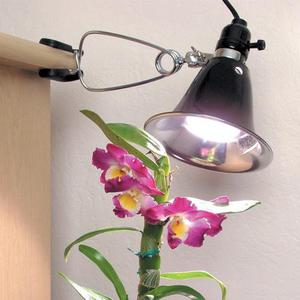 It is quite easy to organize optimal light conditions for a plant. Why do you need to remember in what natural conditions orchids grow. The light from the sun reaches the plant only through the foliage of the trees.
It is quite easy to organize optimal light conditions for a plant. Why do you need to remember in what natural conditions orchids grow. The light from the sun reaches the plant only through the foliage of the trees.
That is, pick for your flower western and eastern window sills... In this case, Phalaenopsis will be comfortable both on the windowsill and near it.
If the plant is located on the south side, then you need take care of shading from direct natural light.
As for the north side, you can also install an orchid here, but on cloudy days you need arrange additional light.
Like most plants, the orchid stretches towards the light and bends out of shape, or even falls out of the pot. To prevent this, it is enough to periodically unfold Phalaenopsis.
Temperature regime and air humidity
 In summer, the temperature must be 24-29 degrees, in winter - 19-26 degrees. If you want the plant to start blooming, provide it with a night temperature drop of about 6 grams.
In summer, the temperature must be 24-29 degrees, in winter - 19-26 degrees. If you want the plant to start blooming, provide it with a night temperature drop of about 6 grams.
What about the temperature regime in winter - the main thing is respond in a timely manner a strong drop in temperature when the orchid pot is near the window. A drop of 11-16 grams will lead to the death of the orchid. The main symptom of hypothermia in Phalaenopsis is the loss of elasticity and wrinkles on the foliage.
Given the climate where the Phalaenopsis orchid grows, the plant needs high air humidity - not less than 55%. It is rather difficult to achieve these conditions in winter, when the main heating works. You can fix this problem in the following ways:
- Organize a moisture source. Pour small pebbles into the pan and add a little water. Place a pot with an orchid in the pallet.
- Spray the plant once a day. But you need to do this sutra so that the orchid is dry until evening.
- Make a barrier between Phalaenopsis and the radiator.
Fertilizer and bait, reasons for transplanting
 The orchid receives all the required nutrients through the roots. That is, you need to use fertilizers that dissolve in water.
The orchid receives all the required nutrients through the roots. That is, you need to use fertilizers that dissolve in water.
Before bait, the plant must be watered, then fed and wait until the excess water comes off. The damaged plant is not watered with water with top dressing, but sprayed.
We must not forget that the orchids in the stores are fed special growth promoters, and fertilizers that dissolve in the pot for a long time.
Before feeding or replanting the acquired plant, you need to free it from these special fertilizers. Let Phalaenopsis a few months take a break from the store bait and only, then it can be poured a little with top dressing.
Professional florists identify several reasons why an orchid should be transplanted:
- Phalaenopsis has a damaged root;
- The roots of the plant do not fit in the pot and push the soil out.
Root damage appears after improper care, for example, poor watering, the pot is flooded with water, the wrong soil is selected, the lack of a drainage system. Therefore, experts recommend explore the features of this plant or watch a tutorial video, how to transplant an orchid.
Features of the choice of a pot, land and transplant
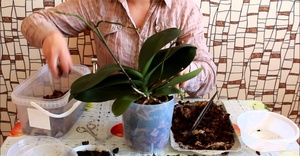 A transparent pot is considered the best container for Phalaenopsis when transplanting, so you will timely detect root diseases and create the required amount of light for them. If you need to transplant an orchid, then the soil must include: charcoal and bark; perlite and moss.
A transparent pot is considered the best container for Phalaenopsis when transplanting, so you will timely detect root diseases and create the required amount of light for them. If you need to transplant an orchid, then the soil must include: charcoal and bark; perlite and moss.
As for the proportions, they are selected taking into account the content of the flower. Usually the air in apartments is dry. In this case, the soil must contain at least 1/3 of the moss. If the room has high humidity, then a little moss is added.
Very often, for beginners, the difficult question is how to properly transplant an orchid into high-quality soil. Therefore, you can just buy special mixture of substance in the store and transplant the flower into it.
Phalaenopsis preparation for transplant:
- Remove the orchid from the pot and brush the roots off the ground.
- Gently wash the roots with water and cut off dry and rotten shoots.
- If the root system is in serious condition and you want to remove its main part, then you need to carefully look after the flower in the future.
Phalaenopsis transplant process:
- Pour drainage into another pot.
- Fill the pot 1/3 full with soil.
- Place the roots of the plant in the pot and carefully cover it with soil so that the earth envelops the root system.
- Gently press down on the roots and add the required amount of soil.
- Pay attention, it is forbidden to cover aerial roots with earth.
- Also, you do not need to cover the leaves and the place of growth of the orchid.
How to care for an orchid after transplanting at home
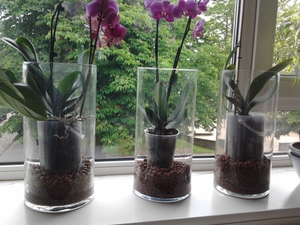 If Phalaenopsis was healthy before the transplant, then there will be no problems associated with this. Water this plant as usual. When you see the growth of a bush, you can start bait every second watering.
If Phalaenopsis was healthy before the transplant, then there will be no problems associated with this. Water this plant as usual. When you see the growth of a bush, you can start bait every second watering.
If the orchid was sick before transplanting, or you cut a lot of roots, then you need to organize the necessary moisture for the plant. Why place the plant pot in a transparent bag and ventilate every two days.
Transplanting an orchid after buying into another pot
Most often, orchids are not transplanted immediately after purchase in stores, but simply enjoy beautiful flowers. However, there are a number of cases when a transplant is required:
- the pot does not have enough soil, the roots cannot support;
- orchid in a pot does not hold on by itself and falls;
- just decided to transplant the orchid into your favorite pot;
- any problems with the Phalaenopsis root system.
How to properly trim Phalaenopsis
 A clear sign that the time of drying is approaching is the buds that are losing their elasticity and become, as it were, waxy. But do not rush to take up the scissors and cut the peduncle.
A clear sign that the time of drying is approaching is the buds that are losing their elasticity and become, as it were, waxy. But do not rush to take up the scissors and cut the peduncle.
Of course, an orchid with dull flowers does not look very beautiful, but flower growers advise move the pot an inconspicuous place with a plant and wait a certain time.
Even when there are no buds on your Phalaenopsis, and the peduncle is still green, do not cut it off. It's just that the orchid can begin to bloom again, and the buds appear in any unexpected areas: the sinus of the former peduncle, at the base of the rosette.
You can only cut the peduncle after final drying, in this case, a dry unsightly yellowed stem remains.
Sometimes pruning is used only for the formed peduncle to shape the plant. This option is relevant if your plant has 2 peduncles, due to the branching of one. So, it is very difficult for orchids to keep large flowers on several branches.
Phalaenopsis pruning is done between flowering and is pruned by 2/3 of the peduncle. After the flower will form another shoot, or the old one will die off.
Features and flowering time, care
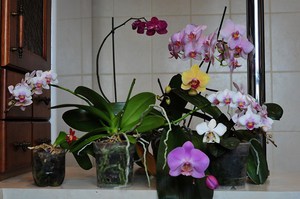 The flowering time takes place from the time of the opening of the first flower. First, the lateral parts open, after the upper petal, then the lip is noticeable. The bud opens for about a day. But then the flower grows for a certain time: the color becomes richer, the petals increase slightly.
The flowering time takes place from the time of the opening of the first flower. First, the lateral parts open, after the upper petal, then the lip is noticeable. The bud opens for about a day. But then the flower grows for a certain time: the color becomes richer, the petals increase slightly.
First, the buds that appear before the rest will open. They are located at the end of the peduncle. These flowers will be the largest. The closer the bud is to the peduncle, the smaller it will be.
The orchid takes about 3 months to bloom. At this time, Phalaenopsis no need to disturb and move to another place. If you want the orchid to delight with flowers as long as possible, then provide the plant with comfortable conditions that allow it to accumulate strength for the formation of buds and their long flowering.
As for watering, additional light and temperature regime, it is not necessary to change them during flowering, but the number of baits is increased to once a week.
If the plant hasn't bloomed for as long as expected immediately after purchase, don't worry. This is a normal reaction to a change in environment.Give orchids some time and next time they will certainly delight you with bright and beautiful flowers.
Probably some content and orchid care at home may sound complicated. But in fact, Phalaenopsis is very hardy and unpretentious.
It is enough just to take care of the humidity of the air, to choose a comfortable and correct location for this plant and not to frequent it with watering. Orchid will bloom for a very long time, and delight you with their flowers, so much like butterflies.

